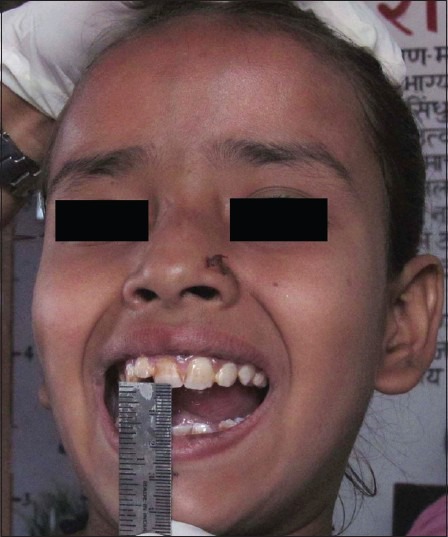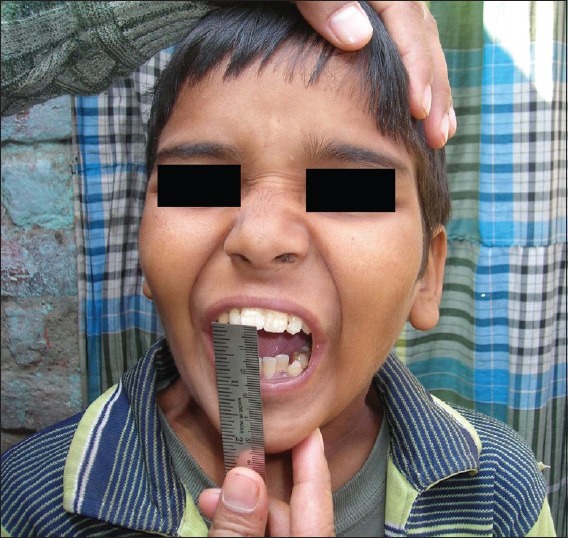Oral submucous fibrosis at pediatric age, now time to think: Series of two cases
CC BY-NC-ND 4.0 · Indian J Med Paediatr Oncol 2013; 34(02): 107-110
DOI: DOI: 10.4103/0971-5851.116194
Abstract
The younger generation is consuming areca nut and areca nut products, which is coming in the market with different multicolored attractive pouches and easily available in each and every corner of the road. For the children from the lower socioeconomic strata, areca nut use is rampant. Alarmingly, it has been seen that the highest period of risk for engaging in areca nut alone is between the ages of 5 and 12. Oral submucous fibrosis associated with areca nut in children is a great concern for the Society and the Government. Factors associated with this report for consuming areca nut are levels of awareness, household environment, peer pressure, low cost, easy availability etc.
Publication History
Article published online:
20 July 2021
© 2013. Indian Society of Medical and Paediatric Oncology. This is an open access article published by Thieme under the terms of the Creative Commons Attribution-NonDerivative-NonCommercial-License, permitting copying and reproduction so long as the original work is given appropriate credit. Contents may not be used for commercial purposes, or adapted, remixed, transformed or built upon. (https://creativecommons.org/licenses/by-nc-nd/4.0/.)
Thieme Medical and Scientific Publishers Pvt. Ltd.
A-12, 2nd Floor, Sector 2, Noida-201301 UP, India
Abstract
The younger generation is consuming areca nut and areca nut products, which is coming in the market with different multicolored attractive pouches and easily available in each and every corner of the road. For the children from the lower socioeconomic strata, areca nut use is rampant. Alarmingly, it has been seen that the highest period of risk for engaging in areca nut alone is between the ages of 5 and 12. Oral submucous fibrosis associated with areca nut in children is a great concern for the Society and the Government. Factors associated with this report for consuming areca nut are levels of awareness, household environment, peer pressure, low cost, easy availability etc.
INTRODUCTION
Oral submucous fibrosis (OSMF) is a chronic debilitating disease of the oral cavity characterized by inflammation and progressive fibrosis of the submucosal tissues (lamina propria and deeper connective tissues). Oral submucous fibrosis results in marked rigidity and an eventual inability to open the mouth.[1,2]
Areca nut is the fourth most commonly used substance of abuse in the world after tobacco, alcohol and caffeine.[3] Its use is deeply ingrained in the socio-cultural practices of the nation and believe that consuming supari is not harmful. Area nut chewing, by itself or in combination with scents, condiments or sweeteners is an accepted practice in part of the western pacific and many South and South-East Asian counties, including India and neighboring countries of India.[4,5,6]
OSMF are considered a significant public health problem in many parts of India and are more often observed in low socioeconomic status population. In recent years, there has been a marked increase in the occurrence of OSMF in the younger generation, which is due to consuming of areca nut and its products that is coming in the market with different multicolored attractive pouches and easily available in each and every corner of the road.
In children from the lower socioeconomic strata or marginalized communities of India, areca nut and its product use is rampant. Alarmingly or a great concern, it has been observed that the highest period of risk for engaging in areca nut alone is between the ages of 5 and 12.
The present cases were reported accidentally during the “School oral health screening program” and “Community oral health screening program” that described a series of two cases of OSMF.
CASE REPORTS
Case 1
In 2009, a 11-year-old Indian Muslim girl was referred to the Oral Medicine Clinic, CSM Medical University, Lucknow, India by Public Health Dentist during “School oral health care program”, with a complaint of reduced mouth opening, discomfort and a burning sensation particularly when eating spicy foods.
Patient showed history of areca nut chewing since seven year; the reduced mouth opening was noticed from past one year, with discomfort and a burning sensation particularly when eating hot and spicy foods.
Intraoral examination revealed that her entire oral mucosa was pale, especially the buccal mucosa, which does not show areas of erosion and the hard palate, which was completely blanched or opaque. Her tongue, uvula and soft palate were normal.
Dental examination reveals carious lesion in posterior tooth and poor oral hygiene.
Physical examination reveals a mouth opening of 14 mm and absence of fibrotic bands.
Case 2
In 2011, another 10-year-old Indian Muslim boy who had not been attending school at all was referred to the Oral Medicine Clinic, CSM Medical University, Lucknow, India by Public Health Dentist during the “Community oral health screening program”, with a complaint of reduced mouth opening, discomfort and a burning sensation particularly when eating spicy foods.
Patient showed history of areca nut chewing since six year; the reduced mouth opening was noticed from past eight month, with discomfort and a burning sensation particularly when eating hot and spicy foods and loss of gustatory sensation.
Clinical examination of soft tissue of oral cavity reveals blanched or opaque appearance of mucosa, reduced mobility of the soft palate and tongue, loss of tongue papillae and dryness of the mouth.
Dental examination reveals dental fluorosis in the anterior teeth, carious lesion in posterior tooth and a poor oral hygiene.
Physical examination reveals mouth opening is 13 mm, with presence of palpable fibrous band especially in the retro molar area but does not involve the uvula and tonsil.
Factor involved in consumption of meethi supari in both the cases
- Level of awareness – both children were not aware that areca nut use was dangerous and harmful to health.
- Household environment – both children living in joint family and most of the family members have the habit of areca nut product in different form like gutka, pan and supari and they were also asked to buy it for them.
- Reasons for initiation – in both cases, peer pressure is the cause of experimentation.
- Availability – Easily available at roadside and nearby home.
- Monies expend – Children spent sums ranging from 0.50 to 2 Rupees per day.
- Low cost – Within reach of the smallest amount of pocket money.
- Source of money spent – In both cases, parents were the common source of money acquired and interestingly the parents were aware of how the money was being used.
MANAGEMENT
Case 1
After rule out of nutritional deficiency, the patient as well as her parents were advised to stop chewing areca nut and return for follow-up in 1 month with regular monitoring of mouth opening. Patient is advised to do mouth-opening exercises, for example, by placing ice cream sticks in their mouth and gradually increasing the number. Instruct the patients to avoid spicy foodstuffs and to eat a complete and healthy diet to avoid malnutrition. Maintain the oral hygiene with a monthly review [Figure 1].

| Fig. 1 Case 1
After quitting the habit, the child is responding after few months with improvement in mouth opening (42 mm) after 8 months and there was also symptomatic relief like burning of mouth with hot and spicy food.
Case 2
Patient as well as parents were informed about the seriousness of condition; however they did not visit the institution until 8 months, after which a representative was sent from our department to know if he had stopped the use of areca nut. It was found that he had not stopped chewing areca nut although he reported a reduction in the frequency of use [Figure 2].

| Fig. 2 Case 2
DISCUSSION
School is the place where student learn under supervision of teacher and in Case 2, the child has not been attending school. Children of his age learn important things of life, hence regular school attendance is an important part of giving child the best possible start in life.
All cases belonged to the lower socioeconomic status and the study[7] also reported a very high frequency of areca nut use especially among children of lower socioeconomic areas, which would increase the burden of this devastating disease in groups who are already deprived of quality health care.
Culturally associated health-risk behaviors, which contribute to morbidity and mortality in later life, often are established during childhood, extended to adulthood, are interrelated and are preventable. It is likely that children who are regular chewers at early age will be dependent on the nut and continue the chewing habit into their adult life, unless an appropriate intervention is made. It was alarming to note the development of oral mucosal lesions in these children, associated with the habit of areca nut chewing.
In the first case, the disease was at a very early stage and the patient showed the classical clinical presentation of burning sensation, pale and blanching mucosa due to habit of chewing areca nut. When this patient quit the habit of areca nut, burning sensation has gone and blanching of mucosa has been reduced. The authors[8,9,10] reported little improvement of mucosal lesion as well as clinical symptoms when areca nut and tobacco chewing habit is discontinued in early stage of disease.
Periodic biopsies of suspicious regions of the oral mucosa are essential for early detection and management of high-risk oral premalignant lesions and prevention of cancer; however, in these cases the patients and parents were not ready to go for biopsy due to fear that biopsy at this age would give psychological and mental trauma to children. The diagnosis is completely based on patient history and clinical examination.
Steps need to be taken at the public health level by creating awareness among the general public about the hazardous nature of these products by appropriate health messages through educational campaign in the community, in the schools, in newspapers (especially local language) and in the multimedia and through passing legislation to ban the sale of supari to very young children. In addition, training of school teacher is also essential as they were also encountered many times with this condition (reduced mouth opening).
It is believed that oral health professionals can and should ascertain and record the use of meethi supari status of children patients on a routine basis, seek new ways to motivate and encourage users to quit, deliver brief cessation advise at every opportunity and advocate for the inclusion of training of cessation methods in dental school curricula as well as in the continuous education programs of their respective professional bodies.
Preventing onset of areca nut use and intervention programs in the early period are essential on priority basis to bring behavioral change in children especially in areca nut consuming states of India, and also future research is needed to examine several dimensions of religiousness in children as predictors of subsequent areca nut use.
The present report describes OSMF in childhood. However, health professional should be reminded of the condition since it may well be seen more frequently in the future, and an active preventative approach is required to children to hopefully limit the potential development of oral lesion.
Footnotes
Source of Support: Nil
Conflict of Interest: None declared.
REFERENCES

| Fig. 1 Case 1

| Fig. 2 Case 2


 PDF
PDF  Views
Views  Share
Share

